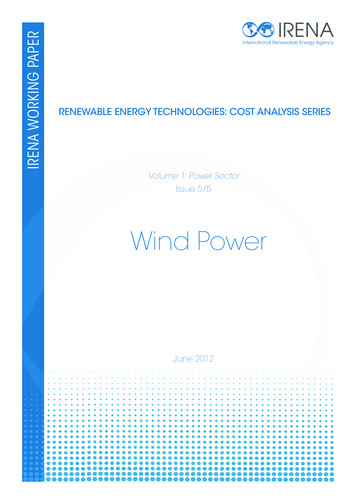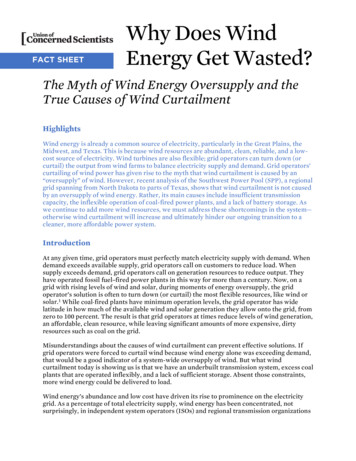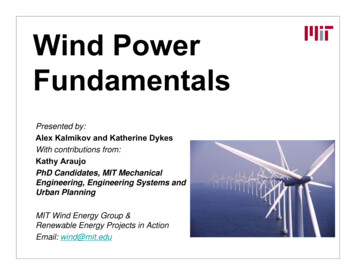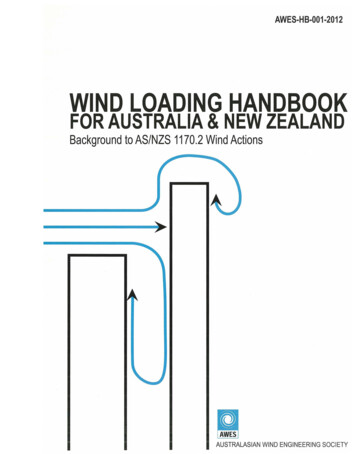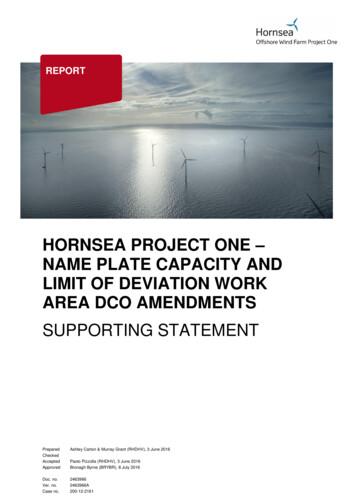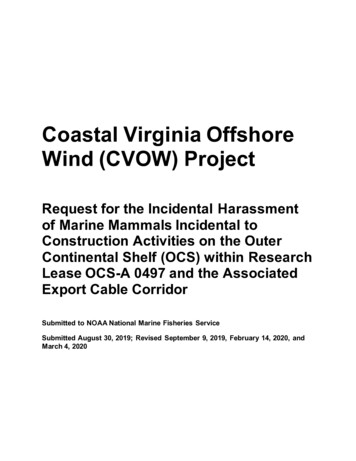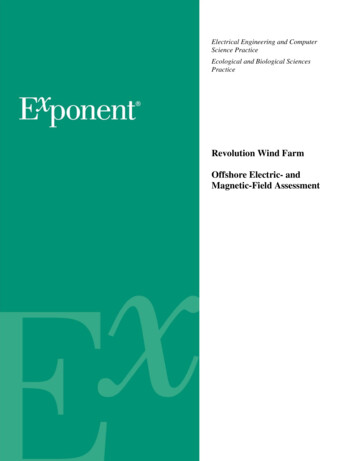
Transcription
Electrical Engineering and ComputerScience PracticeEcological and Biological SciencesPracticeRevolution Wind FarmOffshore Electric- andMagnetic-Field Assessment
Revolution Wind FarmOffshore Electric- and MagneticField AssessmentPrepared forRevolution Wind, LLC.56 Exchange TerraceSuite 300Providence, RI 02903Prepared byExponent17000 Science DriveSuite 200Bowie, MD 20715March 2021 Exponent, Inc.1807897.000 - 1820
March 2021ContentsPageList of FiguresivList of TablesvAcronyms and AbbreviationsviLimitationsviiiExecutive SummaryixIntroduction1Project Description1Magnetic Fields and Induced Electric Fields3Electric and Magnetic Field Exposures and GuidelinesHuman ExposureExposure of Marine Species445Cable Configurations and Calculation MethodsProject CablesModeling Methods778WTGs and OSSsModeling Geometry for WTGs and OSSsModeling Methods9910Calculated Magnetic and Induced Electric Fields11Fields from Project CablesMagnetic-Field LevelsElectric-Field Levels Induced in SeawaterElectric-Field Levels Induced in Marine Organisms11111415WTGs and OSSsOSSsWTGs161618Evaluation of EMF Exposure to Large Invertebrates in the Project Area1807897.000 - 1820ii19
March 2021Magnetosensitivity in Large Marine InvertebratesEvidence from Field Studies2021Evaluation of EMF Levels Produced by the Project Cables23Evaluation of EMF Exposure to Finfish in the Project Area24Important Finfish Species Residing in the Project Area24Behavioral Responses to EMF from 50- and 60-Hz AC SourcesField Studies of Finfish Distribution around Submarine CablesElectrosensitivity of Sturgeon Species262829Evaluation of EMF Exposure from the Project Cables30Assessment of EMF Exposure to Elasmobranchs in the Project Area32Elasmobranch Species Residing in the Project Area32Magnetosensitivity and Electrosensitivity of ElasmobranchsField Studies of Elasmobranch Distribution around Submarine Cables on3334Evaluation of EMF Exposure from Project Cables34Assessment of EMF Exposure to Hardground-Associated Species from the OSSs andWTGs36Description of Reef Communities in the Project Area36Studies of Long-Term Exposure to AC EMF on Fish37Evaluation of EMF Levels at Mattress-Covered Project Cables38Evaluation of EMF Exposure from OSSs and WTGs39Conclusions40References42Attachment A Cable Configurations and Burial DepthsAttachment B Calculation Methods and AssumptionsAttachment C Calculated Magnetic- and Electric-Field Levels for Modeled CableConfigurations1807897.000 - 1820iii
March 2021List of FiguresPageFigure 1.Overview of the proposed RWF and RWEC routes.Figure 2.Indicative illustration of the geometry of cables connecting to a) a WTG andb) an OSS.10Calculated magnetic-field levels in seawater above the 275-kV RWEC for a3.3-foot (1 m) burial depth and average loading.12Calculated magnetic-field levels in seawater above the two 66-kV IACs fora 3.3-foot (1 m) burial depth and average loading.12Calculated magnetic-field levels in seawater above the two 275-kV RWECLandfall Cables for a 3.3-foot (1 m) burial depth and average loading.13Visual comparison of modeled magnetic fields around the RWEC and IACsattached to the OSS.17Figure 3.Figure 4.Figure 5.Figure 6.1807897.000 - 1820iv2
March 2021List of TablesPageTable 1.Calculated magnetic-field levels (mG) at 3.3 feet (1m) above the seabed fora 3.3-foot (1 m) burial depth and average loading14Calculated induced electric-field levels (mV/m) at 3.3 feet (1 m) above theseabed for a 3.3-foot (1 m) burial depth and average loading15Calculated electric-field levels (mV/m) induced in marine organisms at 3.3feet (1 m) above the seabed for a 3.3-foot (1 m) burial depth and averageloading15Calculated volume-averaged induced electric-field (mV/m) and magneticfield levels (mG) around the OSS and WTGs18Table 5.Important large invertebrate species expected to inhabit the Project Area20Table 6.Finfish species expected to inhabit the Project Area25Table 7.Calculated maximum magnetic field and induced electric field (usingsturgeon model) at 3.3 feet (1 m) above seabed for 3.3-foot (1 m) burialdepth and peak loading31Table 8.Elasmobranch species projected to inhabit the Project Area32Table 9.Calculated maximum magnetic field and induced electric field (usingdogfish model) at 3.3 feet (1 m) above seabed for 3.3-foot (1 m) burial depthand peak loading35Table 2.Table 3.Table 4.1807897.000 - 1820v
March 2021Acronyms and AbbreviationsµTMicroteslaAAmpereACAlternating currentBOEMBureau of Ocean Energy ManagementDCDirect currentEMFElectric and magnetic fieldsHDDHorizontal directional drillingHzHertzIACInter-Array CableICESInternational Committee on Electromagnetic SafetyICNIRPInternational Commission on Non-Ionizing Radiation ProtectionIEEEInstitute of Electrical and Electronics EngineerskmKilometerkVkilovoltLease AreaRenewable Energy Lease Area OCS-A lamV/mMillivolts per meterMWMegawattOCSOuter Continental ShelfODOuter diameterOrstedOrsted US Wind Power, LLCOSSOffshore substationOSS-Link CableOffshore substation interconnector cableProjectRevolution Wind Farm projectRevolution WindRevolution Wind, LLC.RWECRevolution Wind Export Cable1807897.000 - 1820vi
March 2021RWEC Landfall Cables RWECs connecting the offshore exit pit to the TJBs at shore landingsRWFRevolution Wind FarmTJBTransition joint bayVHBVanasse Hangen Brustlin, Inc.WTGWind turbine generator1807897.000 - 1820vii
March 2021LimitationsAt the request of Vanasse Hangen Brustlin, Inc. (VHB) and Revolution Wind, LLC.(Revolution Wind)1, Exponent modeled the electric- and magnetic-field levels associated withthe operation of the submarine cables proposed for the Revolution Wind Farm Project.This report summarizes the analysis performed to date and presents the findings resulting fromthat work. In the analysis, we have relied on cable design geometry, usage, specifications, andvarious other types of information provided by VHB and Revolution Wind. We cannot verifythe correctness of this input data and rely on VHB and Revolution Wind for the data’s accuracy.Although Exponent has exercised usual and customary care in the conduct of this analysis, theresponsibility for the design and operation of the Revolution Wind Farm Project remains fullywith the client. VHB has confirmed to Exponent that the data contained herein are not subjectto Critical Energy Infrastructure Information restrictions.The analyses presented herein are made to a reasonable degree of engineering and scientificcertainty. Exponent reserves the right to supplement this report and to expand or modifyopinions based on review of additional material as it becomes available, through any additionalwork, or review of additional work performed by others.The scope of services performed during this investigation may not adequately address the needsof other users of this report, and any re-use of this report or its findings, conclusions, orrecommendations presented herein for purposes other than intended for project permitting are atthe sole risk of the user. The opinions and comments formulated during this assessment arebased on observations and information available at the time of the investigation. No guaranteeor warranty as to future life or performance of any reviewed condition is expressed or implied.1Revolution Wind is a 50/50 joint venture between Orsted North America Inc. and Eversource Investment LLC.1807897.000 - 1820viii
March 2021Executive SummaryAt the request of Vanasse Hangen Brustlin, Inc. (VHB) and Revolution Wind, LLC. (RevolutionWind)2, Exponent calculated the magnetic fields and induced electric fields associated with theoperation of submarine cables that are proposed to convey electricity generated by theRevolution Wind Farm Project (Project). Field levels were calculated for the submarine InterArray Cables (IAC) connecting individual wind turbine generators (WTG) and offshoresubstations (OSS), and for the submarine Revolution Wind Export Cables (RWEC) runningbetween the offshore substations and the proposed Landfall Work Area in North Kingstown,Rhode Island.The buried (or otherwise protected) submarine cables, as well as cables passing through thewater column at WTGs and OSSs, will be sources of electric and magnetic fields (EMF) in themarine environment. The proximity and likely duration of exposure of marine species to ProjectEMF at these installations will be different from the buried cables, so EMF for these Projectelements are reviewed separately.Over the buried cables, the focus of the assessment is on behavioral reactions of marine speciesto 60-Hertz alternating current (AC) EMF in the offshore environment. The magnetic fields andinduced electric fields are calculated for comparison to the detection thresholds of various localelectrosensitive marine organisms to assess the likelihood of detection or alteration of animalbehavior.Calculated magnetic-field levels above the buried cables were found to be below reportedthresholds for effects on the behavior of magnetosensitive marine organisms and calculatedinduced electric-field levels were found to be below reported detection thresholds of localelectrosensitive marine organisms.In contrast to the buried cables, the WTGs and OSSs are relatively large structures and areexpected to attract some species to this habitat (i.e., a reef effect), as has been observed at otherestablished wind farm sites. Since the physical vertical structure of the WTGs and OSSs will2Revolution Wind is a 50/50 joint venture between Orsted North America Inc. and Eversource Investment LLC.1807897.000 - 1820ix
March 2021attract some species to this new habitat for a relatively greater period of time, regardless of thepresence of EMF, the focus of the assessment is on the potential for any adverse effect of morechronic exposure to EMF.Computational modeling of the proposed installations indicates that the AC magnetic fields andinduced electric fields will be confined to a relatively small region immediately surrounding thecables and associated infrastructure. Modeling results indicate that the average magnetic-fieldstrengths at the OSSs and WTGs are far below levels associated with documented chroniceffects on fish. These findings concur with the conclusions of a 2016 comprehensive review bythe U.S. Pacific Northwest National Laboratory of the ecological impacts of Marine RenewableEnergy development, which concluded that “there has been no evidence to show that EMFs atthe levels expected from MRE [Marine Renewable Energy] devices will cause an effect(whether negative or positive) on any species” (Copping et al., 2016). That conclusion wasreaffirmed in the 2020 comprehensive review “ To date, . . . the general conclusion [is] thatEMFs associated with subsea cables are not harmful and do not pose a risk to biota. Thiswould appear to be an appropriate conclusion for MRE devices and cables because their EMFsignatures are low.” (Copping et al., 2020)Note that this Executive Summary does not contain all of Exponent’s technical evaluations,analyses, conclusions, and recommendations. Hence, the main body of this report is at all timesthe controlling document.1807897.000 - 1820x
March 2021IntroductionProject DescriptionRevolution Wind, LLC. (Revolution Wind), a 50/50 joint venture between Orsted NorthAmerica Inc., and Eversource Investment LLC, proposes to construct and operate theRevolution Wind Farm Project (Project). The wind farm portion of the Project (RWF) will belocated in federal waters on the Outer Continental Shelf (OCS) in the designated Bureau ofOcean Energy Management (BOEM) Renewable Energy Lease Area OCS-A 0486 (LeaseArea). The Lease Area is approximately 20 statute miles (mi) (17.4 nautical miles; 30kilometers [km]) south of the coast of Rhode Island. Other components of the Project will belocated in state waters of Rhode Island and onshore in North Kingstown, Rhode Island. TheProject is proposed to be comprised of up to 100 wind turbine generators (WTG) and will becapable of producing up to 880 megawatts (MW) of electricity.Electricity from the WTGs will be carried at a voltage of 66 kilovolts (kV) over approximately155 mi (250 km) of Inter-Array Cables (IAC), and will be collected at up to two offshoresubstations (OSS). The two substations will be connected by an approximately 9 mi (14.5 km)OSS-Interconnector Cable (OSS-Link Cable). At the offshore substations, the voltage will beincreased to 275 kV and will connect to a new substation in North Kingstown, Rhode Island, viathe Revolution Wind Export Cables (RWEC)—a pair of 275-kV 3-core submarine cables(approximately 50 mi [80 km]).Where the RWECs makes landfall at Quonset Point in North Kingstown, Rhode Island, theRWECs will be spliced to slightly larger 3-core cables (RWEC Landfall Cables), which will beinstalled via horizontal directional drilling (HDD) to transition joint bays (TJBs) within theLandfall Work Area.3 At the TJBs, the RWEC Landfall Cables will be spliced to single-coreOnshore Transmission Cables and will transition to an onshore underground duct bank to a newonshore substation sited adjacent to the existing Davisville Substation. Figure 1 provides anoverview of the offshore Project Area with the proposed location of the RWF and potential3Hereafter all references to RWEC Landfall Cables will refer to cables installed between the offshore exit pit andTJBs installed via HDD .1807897.000 - 18201
March 2021RWEC routes. Note that while other portions of the Construction and Operations Plan refer tothe RWEC routes on the outer continental shelf and in Rhode Island waters (RWEC-OCS andRWEC-RI, respectively), the assessment in this report does not depend on location, so thediscussion below refers to the RWECs as covering both portions.Figure 1.1807897.000 - 1820Overview of the proposed RWF and RWEC routes.2
March 2021Each of the electrical elements for the Project, including the IACs and RWECs—where buriedor otherwise protected and at the WTGs and the OSSs—will be sources of magnetic andinduced electric fields. This report summarizes the 60-Hertz (Hz) magnetic and induced electricfields produced by these submarine cables in the offshore portion of the proposed route, as wellas by a representative WTG and OSS.4 An assessment of the magnetic fields associated withthe Onshore Transmission Cables between the TJBs and the new onshore substation is providedin the companion report titled Revolution Wind Farm Onshore Magnetic-Field Assessment(Exponent, 2020).Magnetic Fields and Induced Electric FieldsMagnetic fields are associated with electricity flowing through the submarine cables and arereported as magnetic flux density in units of milligauss (mG), where 1 Gauss is equal to1,000 mG. Magnetic fields are also reported as microtesla (µT), where 1 mG is equal to 0.1 µT.The strongest magnetic field will occur at the surface of the steel armoring around thesubmarine cable and will decrease rapidly with distance. While an electric field is created bythe voltage applied to the conductors inside the cable, it is entirely shielded from the marineenvironment by grounded metallic sheaths and steel armoring around the cable (Snyder et al.,2019). The magnetic field, however, will induce a weak electric field in the seawater around thecables and in nearby marine species. This induced electric field will vary in strength with theflow of electricity on the cable and, like the magnetic field, will decrease rapidly with distance.Induced electric fields in the marine environment are measured in units of millivolts per meter(mV/m).The magnetic fields and induced electric fields around the conductors will vary depending onload current—expressed in units of amperes (A). Since load current on the conductors will varywith varying power generation (dependent upon the speed of the wind and operational status),measurements or calculations of these fields represent only a snapshot of conditions at onemoment in time. On a given day, throughout a week, or over the course of months or years, the4The Project also includes an Offshore OSS-Link Cable (approximately 9 miles [14.5 km]) and slightly largerdiameter RWEC Landfall Cables, described in greater detail below.1807897.000 - 18203
March 2021magnetic- and induced electric-field levels will also vary. To account for this variability,calculations are performed for annual average load and peak load of the Project, which willprovide the average and maximum field levels expected for the proposed Project. Annualaverage loading and annual peak loading were used to calculate magnetic and induced electricfields in this report.Electric and Magnetic Field Exposures and GuidelinesHuman ExposureThe federal government has not enacted any limits for electric fields or magnetic fields fromland- or marine-based transmission cables or other sources of 60-Hz fields. Similarly, the Stateof Rhode Island also has not established any limits or guidelines for exposure. While landbased exposure to electric and magnetic fields (EMF) from transmission cables is relativelycommon, marine-based submarine cables provide limited opportunity for persons to come inclose proximity to them, although limited exposure is possible for those who may be scubadiving at the seabed directly over the cables.Two international organizations provide guidance on human exposure to magnetic fields. Thisguidance is the result of extensive review and evaluation of relevant research of health andsafety issues, and the limits they propose are designed to protect health and safety of persons inan occupational setting and for the general public. The International Committee onElectromagnetic Safety (ICES), which operates “under the rules and oversight of the Institute ofElectrical and Electronics Engineers (IEEE) Standards Association Board,”5 developed anexposure reference level limit to 60-Hz magnetic fields of 9,040 mG for the general public(ICES, 2019). The International Commission on Non-Ionizing Radiation (ICNIRP), anindependent organization that provides scientific advice and guidance on the health andenvironmental effects of non-ionizing radiation, determined a reference level limit of 2,000 mGfor whole-body exposure to 60-Hz magnetic fields (ICNIRP, 2010). The limits for both ICESand ICNIRP for electric-field exposure are roughly one million times higher than those expectedfrom induced electric fields, so human exposure to electric fields is not discussed further in this5http://www.ices-emfsafety.org/1807897.000 - 18204
March 2021report.Exposure of Marine SpeciesBoth magnetic fields and induced electric fields from submarine cables are of environmentaland ecological interest because research shows that some marine species have specializedsensory receptors that are capable of detecting magnetic fields or electric fields, or both, in thenatural environment (e.g., Taylor, 1986; Klimley, 1993; Lohmann et al., 1995; Hellinger andHoffmann, 2012). Generally, the fields detected by marine organisms are within a very limitedfrequency range, which includes the static magnetic field of the earth (frequency of 0 Hz), thenear 0-Hz induced electric fields produced by ocean currents and fish movement in the earth’sstatic magnetic field, and the electric fields produced by biological processes of fish withfrequencies from 0 Hz to about 10 Hz (Bedore and Kajiura, 2013; Snyder et al., 2019).Assessment ApproachExponent used two separate assessment approaches for evaluating the different Project elementswith respect to EMF exposure of marine species.Buried Cables: Where cables are buried, the interaction of interest will be whether or not EMFcan be detected by sensitive species, and if detected, whether these fields are likely to affect oralter the behavior of these species in a way that could have potentially deleterious populationlevel effects. To perform this assessment, the magnetic-field and induced electric-field levelsassociated with the submarine cables are calculated at a height of 3.3 feet (1 meter [m]) abovethe seabed as relevant reference locations for most mobile marine species above the seabed.6The calculated field levels are then compared to the detection thresholds of various marinespecies expected to be in the Project Area (e.g., sharks; fish, including key groundfish species;and larger crustaceans, such as crabs and lobsters) to assess the likelihood of detection oralteration of animal behavior.6This height is consistent with recommendations in international exposure assessments (e.g., ICES, 2019, andICNIRP, 2010) and is meant to capture species swimming in close proximity to the seabed.1807897.000 - 18205
March 2021OSSs, WTGs, and Cables Covered with Protective Mattresses: In contrast to the buriedcables, the OSSs and WTGs are relatively large structures (at least 36 feet in diameter [11 m]),7and the portion of these structures above seabed will introduce a new habitat, as will the smallportion of cables to be covered by protective mattresses or rock berms (estimated to beapproximately 10% of the total route). These new habitats will attract certain species,regardless of the presence of magnetic and induced electric fields. The assessment of exposureat these new habitats is different than at other locations since the new habitats may encouragecertain fish and shark species to spend a greater amount of time relatively close to thesestructures. Since marine species swimming near these portions of the Project would be expectedto move freely throughout the environment around these structures from top to bottom, aconservative estimate of average exposure over a medium term (hours, days) was obtained bycalculating the average EMF level in a volume of the water column adjacent to these structuresor above the mattress-protected cables. These field levels were compared to those reported inthe scientific literature where physiologic responses were measured over longer periods than aretypically used for acute behavioral studies.7The cited dimensions are for monopile structures. Piled jacket foundations with smaller diameter legs also maybe considered for the OSSs, but would have cables separated by far greater distances, so the monopile structureswere evaluated as the option that would result in the highest EMF levels.1807897.000 - 18206
March 2021Cable Configurations and Calculation MethodsProject CablesExponent calculated the 60-Hz fields from the various submarine cables proposed for differentportions of the Project and compared the calculated levels to assessment criteria to evaluatepotential effects on marine species.Three cable configurations are proposed as part of the Project (detailed descriptions of the cableconfigurations are provided in Attachment A):81. IACs (66 kV) are proposed to be installed between WTGs and between WTGs and theOSSs;2. RWECs (275 kV, double-circuit) are proposed to run from the OSSs to the LandfallWork Area in North Kingston, Rhode Island;9 and,3. Where the RWECs are installed between the exit pit to and the TJBs at shore landings,slightly larger cables (referred to as RWEC Landfall Cables) will be installed by HDD.For most of the route, the cables will be buried to a target burial depth of 4 to 6 feet (1.2 m to1.8 m) beneath the seabed (see Attachment A, Figure A-1); however, for the calculations, aconservative burial depth of 3.3 feet (1 m) has been assumed. Where it is impracticable to burythe cables, they may lie upon the surface of the seabed for short areas and will be covered withprotective concrete mattresses or rock berms. The protective coverings for these short surfacelaid installations will be at least 1 foot (0.3 m) thick. At the Landfall Work Area, the RWECswill be spliced to two slightly larger RWEC Landfall Cables for installation via HDD. At theoffshore exit pit transition to the HDD (over a few tens of feet) the burial depth may less than 15feet (4.6 m) and is conservatively modeled at the same minimum depth of 3.3 feet (1 m) as theRWECs and IACs.8The substation itself is expected to be a minimum of 82 feet (25 m) above mean sea level, so will not be asource of EMF in the marine environment.9Interconnector Cables may also be installed in the Offshore Interconnector Cable Corridor–approximately9 miles (15 km)–if two OSSs are constructed. The Interconnector Cables are proposed to be the same as theRWECs, so are not discussed separately.1807897.000 - 18207
March 2021Evaluations of field levels at these minimum heights are designed to describe the likeliestexposure zone for demersal fish. A detailed table summarizing the modeling inputs for each ofthese cable configurations is shown in Attachment A, Table A-1.Modeling MethodsExponent modeled the magnetic- and induced electric-field levels for each cable configuration,using conservative assumptions designed to ensure that the calculated levels overestimate thefield levels that would be measured above the cables at any specified loading. In addition tousing a conservative minimum target burial for all cases, these conservative models assume noshielding effect of cable sheathing or armoring as well as no field reduction due to helicaltwisting of conductors within the cables. As discussed in Snyder et al. (2019), each of thesefactors will reduce the magnetic field compared to those calculated in this report. The inducedelectric- and magnetic-field levels reported below therefore provide conservative upper boundson the expected field levels surrounding the cables. Additional discussion of these factors ispresented in Attachment B.The RWECs are proposed to be separated by at least 160 feet (50 m), so were modeled inisolation from one another. In contrast, the IACs and RWEC Landfall Cables are proposed to becloser together with minimum separation distances of 9.2 feet (2.8 m) and 49 feet (15 m)respectively, so models of these two configurations included both cables together to account forthe potential additive effects of two closely-spaced cables.10 More detailed descriptions of thecalculation methods for magnetic fields and induced electric fields within marine organisms areprovided in Attachment B.10At the TJBs on land, the separation distance will be somewhat less (23 to 33 feet [7 to 10 m]). Therefore, theRWEC Landfall Cables were conservatively modeled using a separation distance of 16 feet (5 m) toconservatively overestimate field levels.1807897.000 - 18208
March 2021WTGs and OSSsExponent also modeled magnetic- and induced electric-field levels from the WTGs and OSSs(each supported on 36-foot [11-m] diameter monopile or piled jacket foundations).11 The WTGsand OSSs will have the various IACs and RWECs distributed around the circumference of thefoundations,12 and are modeled to approach the WTGs or OSSs at a burial depth of 3.3 feet(1 m). At the base of WTGs or OSS structures, individual cables will be pulled from the base ofthe foundation to the top of the structure through pre-installed black steel j-tubes inside thestructure.13Modeling Geometry for WTGs and OSSsAt any individual WTG, a maximum of three IACs will be present, and each will have anapproach angle relative to one another of not less than 70 degrees. At the OSSs, the RWECs, theOSS-Link Cable, and up to six IACs will be spaced around the circumference of the monopilewith a minimum approach angle of 23 degrees. Electrical current from the WTGs or OSSsflows down the cables inside the monopile wall within the j-tubes. The cables exit the j-tubes ata maximum height of approximately 16 feet (5 m) above seabed, and enter the seabed at anangle of approximately 45 degrees from the vertical, separating from one another radially asillustrated in Figure 3. As the cables exit the monopile they will form a partial “skirt” and asheltered area, which some marine species may utilize as habitat. At the base of the WTGshown in Figure 2a, the minimum horizontal distance between the cables exiting the j-tubes isapproximately 20 feet (6 m). In Figure 2b, the minimum horizontal distance between adjacent jtubes at the base of the OSS is approximately 6.6 feet (2 m).11Magnetic and induced-electric field levels around larger monopiles (e.g., 39 feet [12 m] or 49 feet [15m]) areexpected to be similar to or lower than modeled here because cables would be spaced further apart.12The piled jacket foundations will be installed as four-legs to support rectangular-shaped OSS platforms. The legsupports at seabed will be separated by 120 ft x 110 ft (37 m x 34 m). The separation of IACs, OSS-Link Cable,and RWEC on piled jacket foundations will be greater compared to separation around monopile foundations.Therefore, expected levels of magnetic and induced electric fields are expected to be similar to or greateraround monopile foundations compared to piled jacket foundations.13The diameter of each j-tube is approximately 2.5 times the diameter of the cable.1807897.000 - 18209
March 2021a)Figure 2.b)Indicative illustration of the geometry of cables connecting to a) a WTG andb) an OSS.Modeling MethodsAll calculations for the WTGs and OSSs were performed using the same methods that was usedto the model the EMF from the IACs, RWECs, and RWEC Landfall Cables. In contrast to therelatively simple cable geometry, however, the models of the WTGs and particularly the OSSare substantially more complex. As shown in Figure 2, the separation of the cables away fromthe OSS monopile and their radial divergence requires a significantly larger modeling domain.Similar to the calculations of individual cables, the modeling approach at the WTGs and OSSsincludes a number of factors that will reduce the magnetic-field level compared to thosecalculated in this report (Snyder et al., 2019). The induced electric- and magnetic-field levelsreported below therefore provide conservative upper bounds on the expected field levelssurrounding the cables. A more detailed description of the calculation methods is provided inAttachment B.1807897.0
Revolution Wind Farm Project (Project). Field levels were calculated for the submarine Inter-Array Cables (IAC) connecting individual wind turbine generators (WTG) and offshore substations (OSS), and for the submarine Revolution

